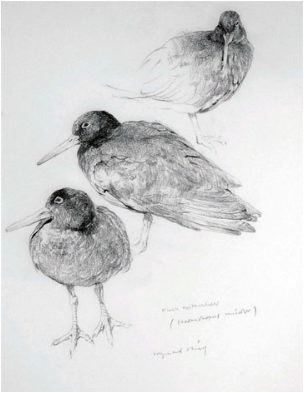|
When I was young and an obsessive birder in training I traveled to a fishing lake not far from home. On the bank of the lake was a female Wood Duck with an injured wing. Up to that point I had only observed this shy species from a distance, and when I witnessed the surprising variety of colors on this close-range specimen I was fooled into thinking it was some exotic rare species that I couldn't identify in my field guide. Remembering that experience I wanted to create a painting that would introduce others to the true character of this "brown duck". They may be surprised to discover that this seemingly modest lady sports a brazen yellow eyeliner. When the purpose of a painting is all about celebrating colors, it may seem counterproductive to choose a limited palette and nearly monochromatic color scheme. But doing so allowed what colors there were in the feathers to remain the highlight. I also chose to portray the duck from a sideways angle. In avoiding a direct pose I hoped to universalize the subject matter and make it into something to be “observed”. So there she is, the female Wood Duck as I see her. Every bit as lovely in her own way as her strikingly-patterned male counterpart.
5 Comments
When I was in college I heard a specific adjective used again and again to describe my work: Mushy. Webster’s definition: “Soft and pulpy”. In other words, I used six or seven sketchy lines when one was enough, I oversimplified my contours, my values were messy, etc. I was thinking on my paper instead of in my head. Since then, I’ve been on a quest to “sharpen” my drawing skills. One of the biggest inspirations in accomplishing my goal has been the work of Ray Harris-Ching, New Zealand bird artist. Here are a few of his sketches: He is a master at capturing minute detail without sacrificing the overall values of the form. I struggle to capture these basic values (highlight, halftone, core-shadow, etc.) when they’re hidden beneath a web of feather patterns. So I practice. Yesterday I sketched a curlew, beginning with the contours: Already my drawing looks over-simplified when compared to Ray Ching's sketches. To finish I drew in the intricate feather pattern, shaded the form, and darkened any details that fell into shadow (in that order). Here’s my final sketch: And now here's a side-by-side of mine (turned black and white) and one of Raymond Ching's so you can compare the level of detail: His ability to capture minute shifts in contours and value contrast wins against mine hands down. You can only draw as well as you can see, so I'll keep working on seeing that hyper-detail. Until next time!
|













 RSS Feed
RSS Feed